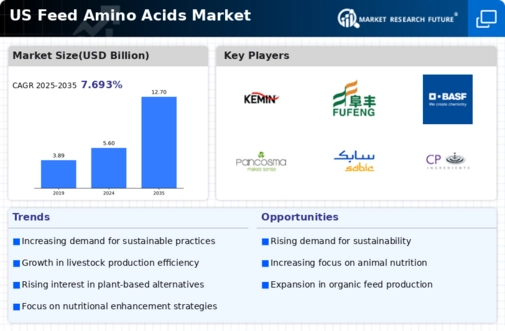Increasing Livestock Production
The feed amino acids market is experiencing growth due to the rising demand for livestock products in the US. As the population increases, so does the need for meat, dairy, and eggs, which drives livestock production. In 2025, the US livestock sector is projected to grow by approximately 2.5%, leading to a higher requirement for feed additives, including amino acids. These compounds are essential for optimal animal growth and health, enhancing feed efficiency and overall productivity. Consequently, the feed amino-acids market is likely to benefit from this trend, as farmers seek to improve their livestock's nutritional profiles to meet consumer demands.
Emerging Trends in Organic Farming
The feed amino acids market is influenced by the rising trend of organic farming in the US. As consumers increasingly demand organic products, farmers are adapting their practices to meet these preferences. Organic livestock production often requires specific nutritional strategies, including the use of amino acids to ensure optimal growth and health without synthetic additives. This shift towards organic practices is expected to drive the feed amino-acids market, as producers seek natural and effective solutions to enhance animal nutrition. By 2025, the organic feed market is projected to grow by 5%, further supporting the demand for amino acid supplements.
Rising Awareness of Feed Efficiency
The feed amino acids market is benefiting from a growing awareness of feed efficiency among livestock producers in the US. As feed costs represent a significant portion of total production expenses, optimizing feed formulations with amino acids can lead to substantial cost savings. By improving feed conversion ratios, producers can achieve better growth rates and overall performance in their livestock. In 2025, it is estimated that the feed amino-acids market will account for approximately 15% of the total feed additives market, highlighting its importance in enhancing feed efficiency and profitability for farmers.
Focus on Animal Health and Nutrition
The feed amino acids market is significantly influenced by the growing emphasis on animal health and nutrition in the US. Livestock producers are increasingly aware of the importance of balanced diets for their animals, which directly impacts productivity and profitability. Amino acids play a crucial role in maintaining animal health, supporting immune function, and promoting growth. In 2025, the market for feed amino acids is expected to reach approximately $1.2 billion, reflecting a compound annual growth rate (CAGR) of around 4.5%. This focus on nutrition is likely to drive demand for high-quality feed additives, positioning the feed amino-acids market as a vital component of modern animal husbandry.
Regulatory Support for Feed Additives
The feed amino acids market is positively impacted by regulatory frameworks that support the use of feed additives in the US. Government agencies, such as the FDA, have established guidelines that promote the safe and effective use of amino acids in animal feed. This regulatory support encourages manufacturers to innovate and develop new products that enhance animal nutrition. As a result, the feed amino-acids market is expected to expand, with an anticipated growth rate of 3.8% annually through 2025. This environment fosters confidence among producers, leading to increased adoption of amino acid supplements in livestock diets.




















Leave a Comment